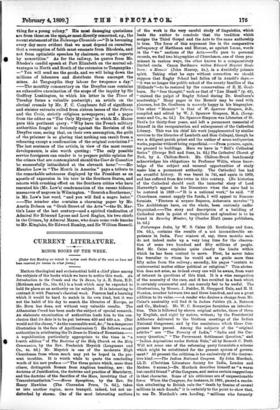CURRENT LITERATURE.
MINOR BOOKS OF THE WEEK.
117nder this Breading we intend to notioe such Books of the week as have not been reserved for review in ocher forms.] Matters theological and ecclesiastical hold a chief place among the subjects of the books which we have to notice this week. An Introduction to the Creeds and the Te Deum, by A. E. Burn, B.D. (Methuen and Co., 103. 6d.) is a book which may be expected to hold its place as an authority on its subject. It is interesting to contrast it with Pearson's classical work. Pearson had a learning which it would be hard to match in its own kind, but it was not the habit of his day to search the libraries of Europe, as Mr. Burn has done, not without very valuable results. The Athanasian Creed has been made the subject of special research. An elaborate examination of authorities leads him to the con- clusion that its date is to be put between 420 and 430 A.D. (But would not the clause, " As the reasonable soul, &c.," be a dangerous illustration in the face of Apollinarianism ?) He follows recent authorities in attributing the Te Deum to Niceta of Remesiana.— A republication particularly appropriate to the time is " a fourth edition " of The Doctrine of the Holy Church on the Holy Communion, by the Rev. Frederick Meyrick (Longmans and Co., 4s. 6d.) Mr. Meyrick is one of the moderate High Churchmen from whom much may yet be hoped in the pre- sent troubles. It is worth while to quote the concluding words of his new preface :—" The three points which, more than others, distinguish Roman from Anglican teaching, are : the doctrine of Justification, the doctrine and practice of Mariolatry, and the doctrine of the Sacrifice of the Mass, involving that of Transubstantiation."—Horas Synopticae, by the Rev. Sir Henry Hawkins (The Clarendon Press, 7s. 6d.), takes us into another region, more tranquil, indeed, but not un- disturbed by storms. One of the most interesting sections of the work is the very careful study of linguistics, which leads the author to conclude that the tradition which assigns the Third Gospel and the Acts to the same authorship is true. The force of this argument lies in the comparative infrequency of Matthtean and Marcan, as against Lucas, words in the " we " sections of the Acts.—To pass to personal records, we find two biographies of Churchmen, one of them pro- minent in various ways, the other known to a comparatively limited circle. Canon Berdmore writes Edward Meyrick Goul- burn: a Memoir (John Murray, 6s.), in a decidedly polemic spirit. Taking what he says without correction we should suppose that Rugby School had fallen off in Arnold's days.- " it was no longer the public school of the county families of the Midlands "—to be restored by the conservatism of E. U. Goal- burn. No "free thought," such as that of "Lux Mundi " (p. 43), " stained the pulpit of Rugby School during Dr. Goulburra's mastership." Many pages in the Memoir may be read with pleasure, but Dr. Goulburn is scarcely happy in his biographer. The other " Memoir " is that of W. Sparrow Simpson, D.D., compiled and edited by W. J. Sparrow Simpson, M.A. (Long- mans and Co., 4s. &I.) Dr. Sparrow Simpson was Librarian of St. Paul's for thirty-four years, and left a permanent memorial of himself in the reorganisation and enlargement of the Cathedral Library. This was his chief life work (supplemented by similar services to the libraries of Lambeth and Sion College), though he was a diligent parish priest and the author of some antiquarian works, popular without being superficial.—Front persons, again, we proceed to buildings. Here we have in " Bell's Cathedral Series" (George Bell and Sons, Is. 6d.) The Cathedral Church of York, by A. Chilton-Brock. Mr. Chilton-Brock handsomely acknowledges his obligations to Professor Willis, whose know- ledge of the subject and unusual opportunities of study make him a permanent authority. The Cathedral has had an eventful history. It was burnt in 741, and again in 1069, and has suffered from fire twice in this century. (No historian of the Cathedral should omit the immortal story of Lord Harrowby's appeal to the Dissenters when the nave had to be restored in 1829 :—" It is a national work," he said. " If Churchmen cannot supply the funds, I will appeal to Noncon- formists. Fleeter° si nequeo Superos, Acheronta movebo.' ") The Archbishops have, on the whole, been curiously undis- tinguished.—The story and description of a building of Cathedral rank in point of magnitude and splendour is to be found in Beverley Minster, by Charles Hiatt (same publishers, Is. 6d.)


































 Previous page
Previous page